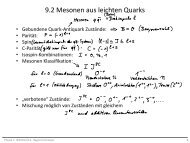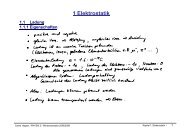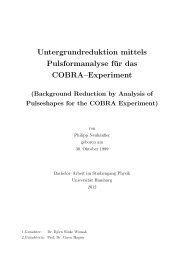Setup of a Drift Tube Muon Tracker and Calibration of Muon ...
Setup of a Drift Tube Muon Tracker and Calibration of Muon ...
Setup of a Drift Tube Muon Tracker and Calibration of Muon ...
You also want an ePaper? Increase the reach of your titles
YUMPU automatically turns print PDFs into web optimized ePapers that Google loves.
asymmetry between neutrino <strong>and</strong> antineutrino oscillations in matter. Determiningthe matter enhanced oscillation parameters ∆m 2 m <strong>and</strong> sin 2θ m from solar neutrinoexperiments <strong>and</strong> combining them with measurements <strong>of</strong> the reactor ¯ν e therefore<strong>of</strong>fers an opportunity to probe the mass hierarchy in the solar sector <strong>and</strong> has providedthat fact that ν 2 is heavier than ν 1 .2.4 Other Neutrino SourcesBesides the Sun, neutrinos originate from many sources, both natural <strong>and</strong> man made.They are involved in nuclear processes as the β decay, fusion <strong>and</strong> fission. Next to ourSun, all stars emit neutrinos, especially when they come to an end: vast amounts<strong>of</strong> neutrinos are released in supernova explosions. Neutrinos are also constantlyproduced in the Earth’s atmosphere. The interaction <strong>of</strong> protons <strong>and</strong> other particleswith the molecules in the atmosphere produces hadronic showers accompanied byneutrinos. But there are not only extra terrestrial neutrino sources. Nuclear powerplants as well as natural radionuclides present inside the Earth emit ¯ν e . Last butnot least, using particles accelerators allows to create high energy neutrino beamsthat can be focused on any given experiment. The large variety <strong>of</strong> neutrino sourcesis discussed in this section.2.4.1 Atmospheric NeutrinosAtmospheric neutrinos are produced from the decays <strong>of</strong> particles in hadronic showersresulting from interactions <strong>of</strong> cosmic rays with the Earth’s atmosphere. In thoseinteractions, mainly pions <strong>and</strong> kaons are produced <strong>of</strong> which then decay ending upwith either photons or a µ-ν µ pair. The muon itself will decay further into anelectron, its corresponding neutrino <strong>and</strong> another muon neutrino. Therefore onewould expect an electron type / muon type neutrino ratio R <strong>of</strong> aboutR = N(ν e + ¯ν e )N(ν µ + ¯ν µ ) ≃ 1 2 . (2.9)These processes mainly take place in the upper troposphere at heights around15 km. Neutrinos originating from the Earth’s atmosphere have much higher energiesthan solar neutrinos ranging from about 100 MeV up to 10 TeV. The expressionatmospheric neutrino suggests that this kind <strong>of</strong> neutrino predominately comes fromthe sky in a downward direction towards Earth. This is obviously not true whenone considers that neutrinos hardly interact. Atmospheric neutrinos simply penetratethe Earth <strong>and</strong> are thus coming from all directions. However, this meansthat a neutrino at the Earth’s surface has traveled a distance ranging from ∼ 15to ∼ 12800 km, depending on its direction, leading to different ν µ neutrino survivalprobabilities. Although the absolute atmospheric neutrino fluxes are hard topredict, these oscillations can be observed in disappearance experiments comparingmeasurements <strong>of</strong> R introduced in Eq. 2.9 with expectations. These measurementscan even be enhanced by including directional information as well as the energy<strong>of</strong> the particle <strong>and</strong> were successfully performed in the 50 kt water Čerenkov detectorSuper-Kamiok<strong>and</strong>e in 1998 [12] that lead to the first experimental evidence <strong>of</strong>neutrino oscillations.15





